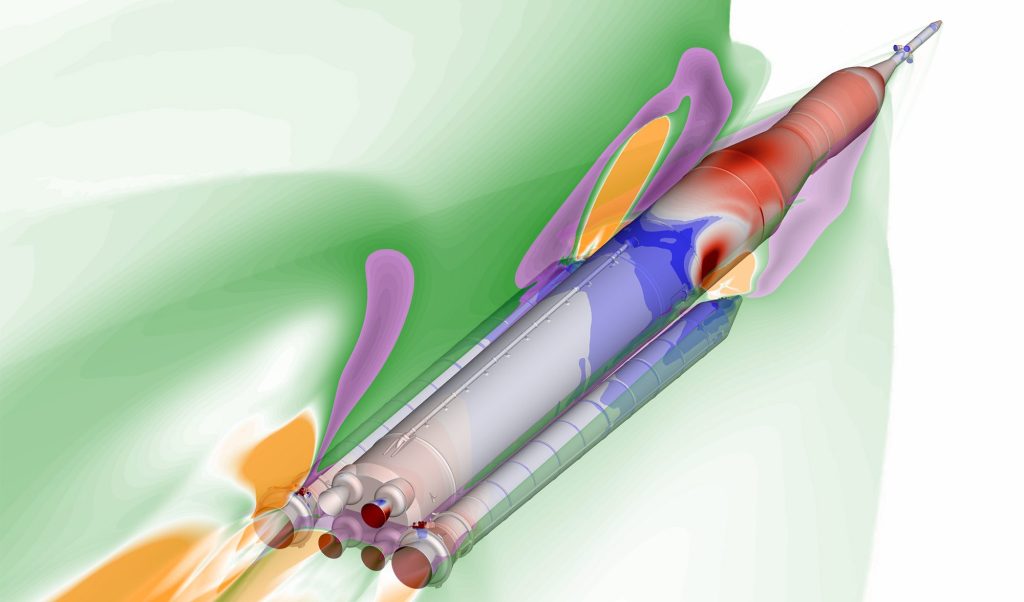1 min read
Cartwheel Galaxy (MIRI Image)
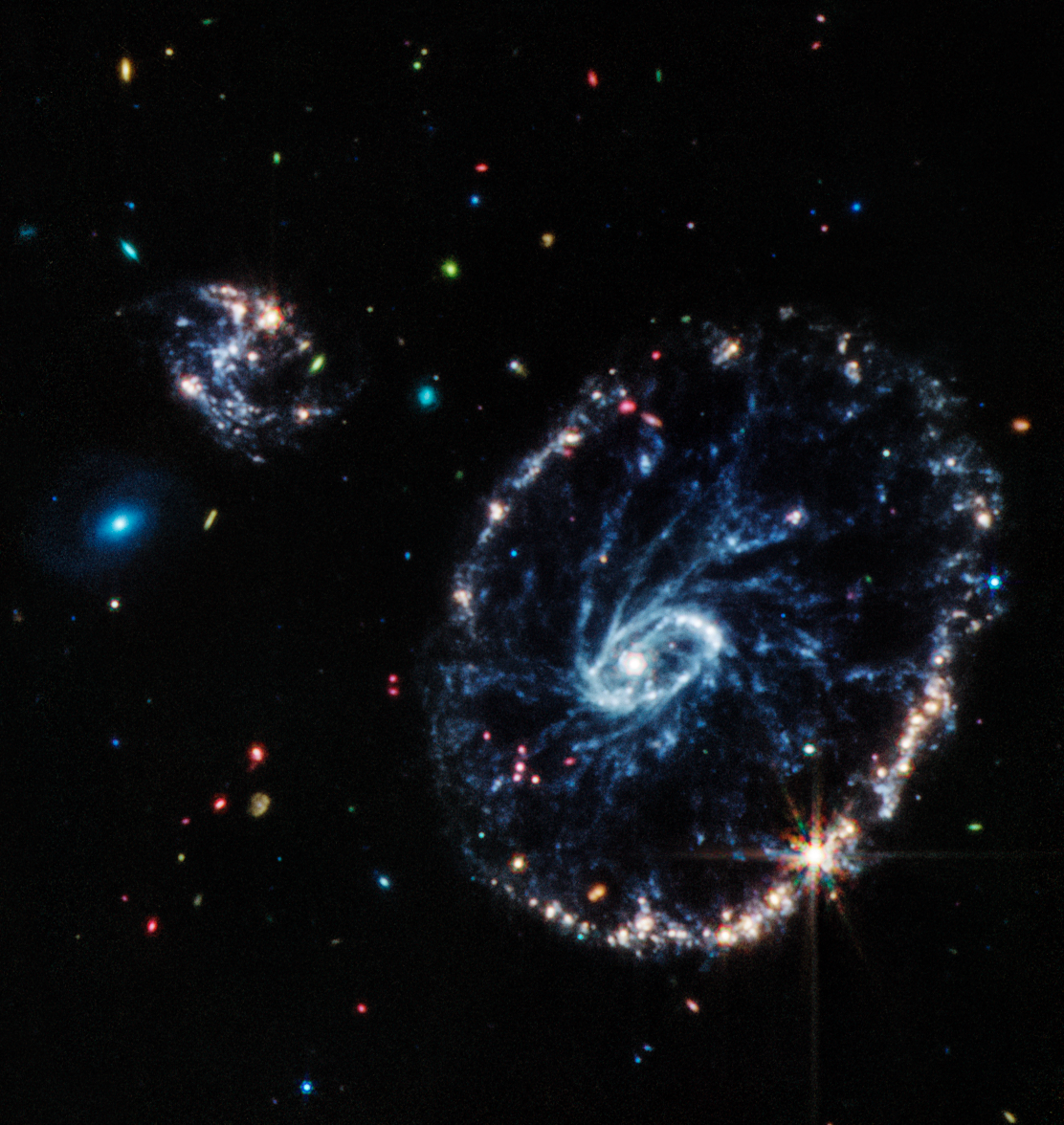
This image from Webb’s Mid-Infrared Instrument (MIRI) shows a group of galaxies, including a large distorted ring-shaped galaxy known as the Cartwheel. The Cartwheel Galaxy, located 500 million light-years away in the Sculptor constellation, is composed of a bright inner ring and an active outer ring. While this outer ring has a lot of star formation, the dusty area in between reveals many stars and star clusters.
The mid-infrared light captured by MIRI reveals fine details about these dusty regions and young stars within the Cartwheel Galaxy, which are rich in hydrocarbons and other chemical compounds, as well as silicate dust, like much of the dust on Earth.
Young stars, many of which are present in the bottom right of the outer ring, energize surrounding hydrocarbon dust, causing it to glow orange. On the other hand, the clearly defined dust between the core and the outer ring, which forms the “spokes” that inspire the galaxy’s name, is mostly silicate dust.
The smaller spiral galaxy to the upper left of Cartwheel displays much of the same behavior, showing a large amount of star formation.
MIRI was contributed by ESA and NASA, with the instrument designed and built by a consortium of nationally funded European Institutes (The MIRI European Consortium) in partnership with JPL and the University of Arizona.
About the Object
- R.A. PositionR.A. PositionRight ascension – analogous to longitude – is one component of an object's position.00:37:41.09
- Dec. PositionDec. PositionDeclination – analogous to latitude – is one component of an object's position.-33:42:59.0
- ConstellationConstellationOne of 88 recognized regions of the celestial sphere in which the object appears.Sculptor
- DistanceDistanceThe physical distance from Earth to the astronomical object. Distances within our solar system are usually measured in Astronomical Units (AU). Distances between stars are usually measured in light-years. Interstellar distances can also be measured in parsecs.500 million light-years (150 Mpc)
- DimensionsDimensionsThe physical size of the object or the apparent angle it subtends on the sky.Image is 2.1 arcmin across (about 305,000 light-years)
About the Data
- Data DescriptionData DescriptionProposal: A description of the observations, their scientific justification, and the links to the data available in the science archive.
Science Team: The astronomers who planned the observations and analyzed the data. "PI" refers to the Principal Investigator.This image was created with Webb data from proposal: 2727. It is part of Webb Early Release Observations.
The Early Release Observations and associated materials were developed, executed, and compiled by the ERO production team:
Jaclyn Barrientes, Claire Blome, Hannah Braun, Matthew Brown, Margaret Carruthers, Dan Coe, Joseph DePasquale, Nestor Espinoza, Macarena Garcia Marin, Karl Gordon, Alaina Henry, Leah Hustak, Andi James, Ann Jenkins, Anton Koekemoer, Stephanie LaMassa, David Law, Alexandra Lockwood, Amaya Moro-Martin, Susan Mullally, Alyssa Pagan, Dani Player, Klaus Pontoppidan, Charles Proffitt, Christine Pulliam, Leah Ramsay, Swara Ravindranath, Neill Reid, Massimo Robberto, Elena Sabbi, Leonardo Ubeda.
The EROs were also made possible by the foundational efforts and support from the JWST instruments, STScI planning and scheduling, Data Management teams, and Office of Public Outreach.
- InstrumentInstrumentThe science instrument used to produce the data.MIRI
- Exposure DatesExposure DatesThe date(s) that the telescope made its observations and the total exposure time.10 June 2022
- FiltersFiltersThe camera filters that were used in the science observations.F770W, F1000W, F1280W, F1800W
- Object NameObject NameA name or catalog number that astronomers use to identify an astronomical object.Cartwheel Galaxy, ESO 350-40, AM0035-335
- Object DescriptionObject DescriptionThe type of astronomical object.Interacting Galaxies
- Release DateAugust 2, 2022
- Science ReleaseWebb Captures Stellar Gymnastics in the Cartwheel Galaxy
- CreditImage: NASA, ESA, CSA, STScI, Webb ERO Production Team

These images are a composite of separate exposures acquired by the James Webb Space Telescope using the MIRI instrument. Several filters were used to sample broad wavelength ranges. The color results from assigning different hues (colors) to each monochromatic (grayscale) image associated with an individual filter. In this case, the assigned colors are: Red: F1800W Yellow: F1280W Green: F1000W Blue: F770W

Related Images & Videos
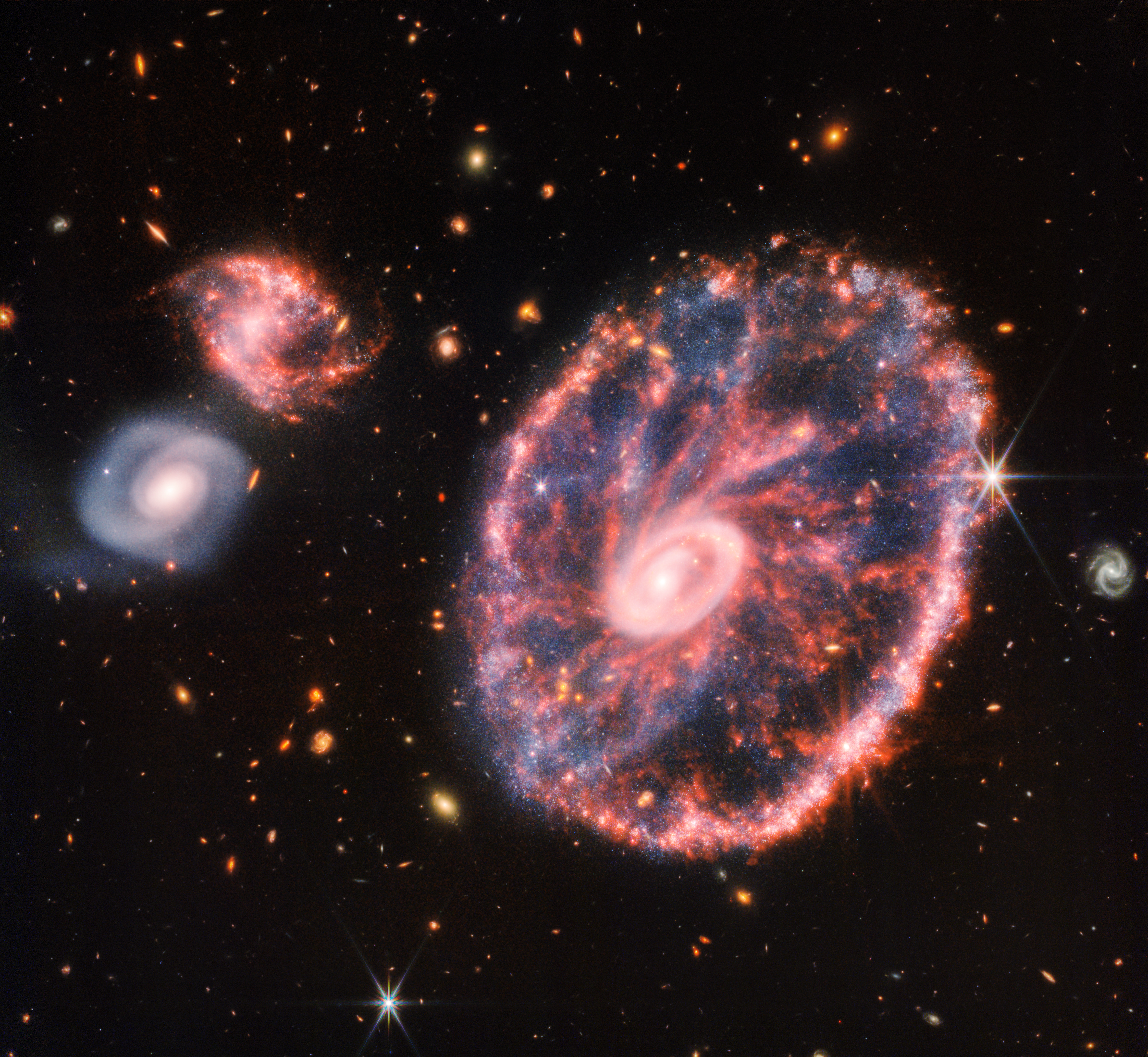
Cartwheel Galaxy (NIRCam and MIRI Composite Image)
This image of the Cartwheel and its companion galaxies is a composite from Webb’s Near-Infrared Camera (NIRCam) and Mid-Infrared Instrument (MIRI), which reveals details that are difficult to see in the individual images alone. This galaxy formed as the result of a high-speed...
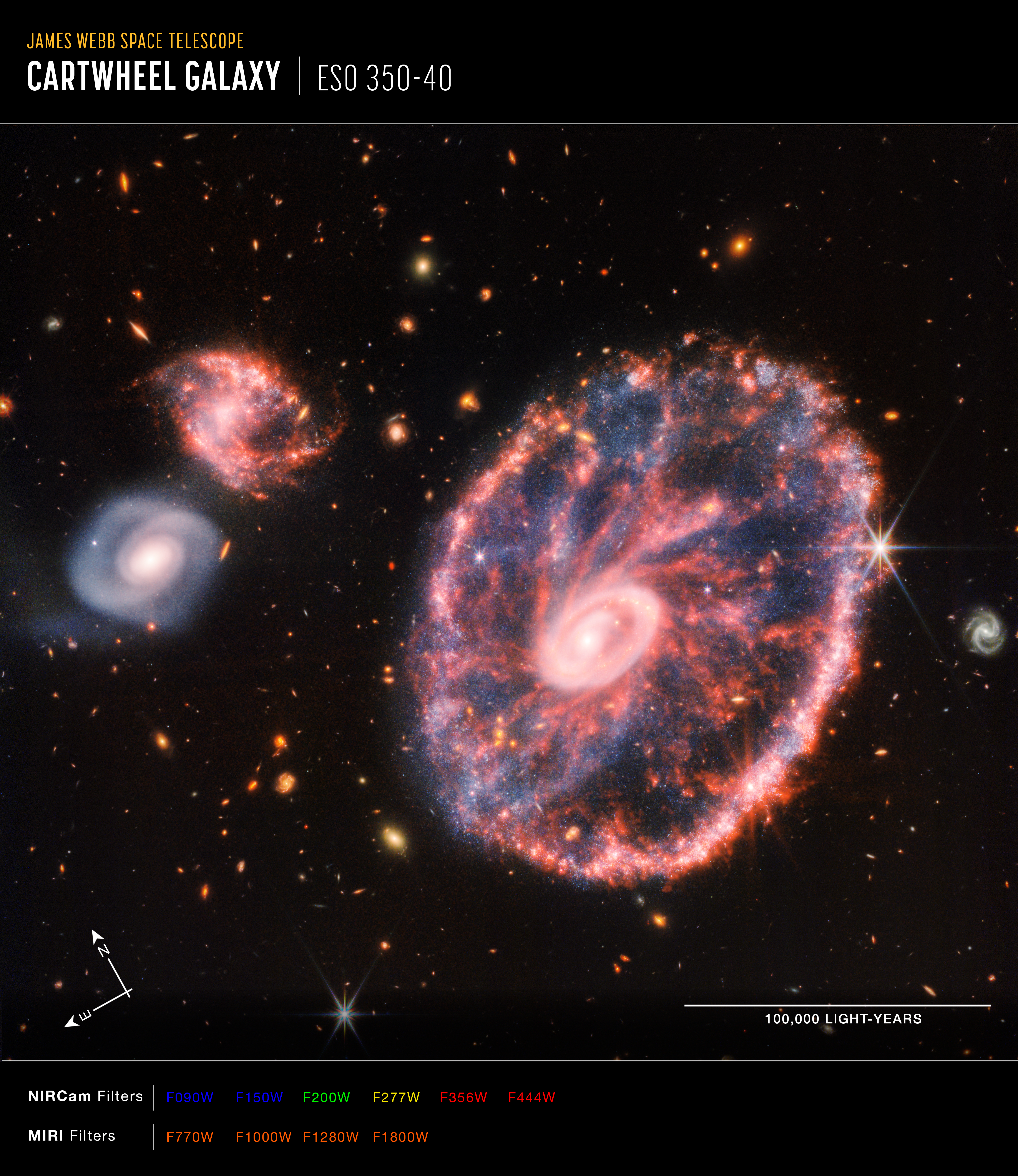
Cartwheel Galaxy (NIRCam and MIRI Composite Compass Image)
Image of the Cartwheel Galaxy, along with two smaller companion galaxies, captured by Webb’s Near-Infrared Camera (NIRCam) and Mid-Infrared Instrument (MIRI), with compass arrows, scale bar, and color key for reference. The north and east compass arrows show the orientation of...
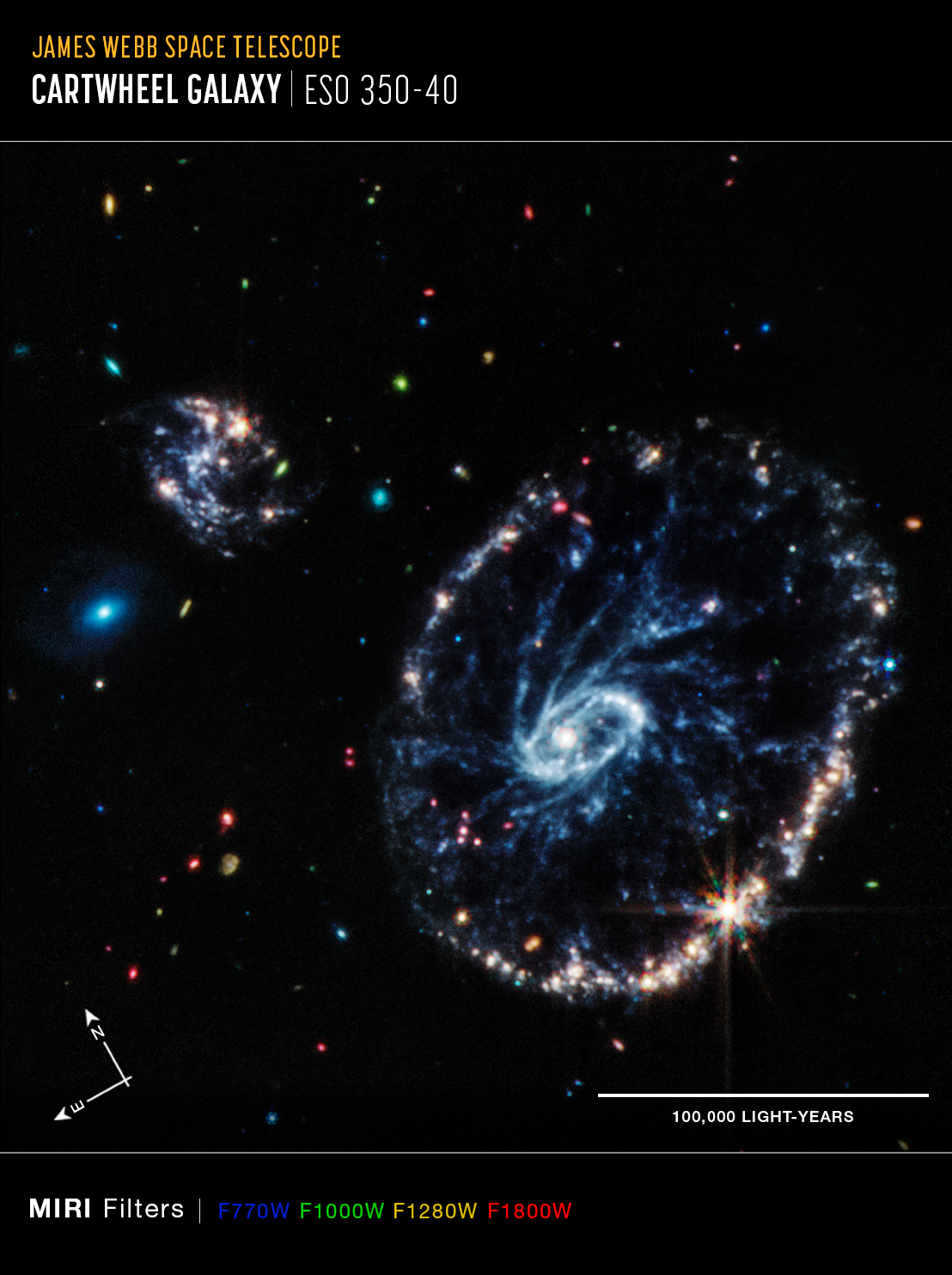
Cartwheel Galaxy (MIRI Compass Image)
Image of the Cartwheel Galaxy, along with two smaller companion galaxies, captured by Webb’s Mid-Infrared Instrument (MIRI), with compass arrows, scale bar, and color key for reference. The north and east compass arrows show the orientation of the image on the sky. Note that the...
Share
Details
Laura Betz
NASA’s Goddard Space Flight Center
Greenbelt, Maryland
laura.e.betz@nasa.gov
NASA, ESA, CSA, STScI, Webb ERO Production Team















